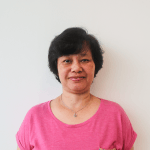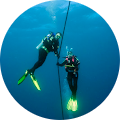Knee Injuries
Knee Pain & Injury Treatment

Knee injuries and knee pain are very common and can have many causes:
- traumatic (e.g. sports injury)
- wear & tear (e.g. arthrosis)
- muscle weakness
- muscle tightness
- overuse
- biomechanical dysfunction
Therefore it is essential to make a correct diagnosis of the underlying cause in order to provide appropriate treatment for an optimal recovery. Injuries may affect muscles, ligaments, meniscus, cartilage, or bones. Most commonly the pain is localized around the injured area and can be felt during activity, after activity or constantly. Many injuries can be treated conservatively with physiotherapy. However, with more severe injuries surgery may be necessary. In this case, the patient will need post-surgical rehabilitation.
Common Knee Injuries:
-
Patellofemoral pain syndrome
The calf consists of two muscles, the gastrocnemius and the soleus. Most injuries happen during sport activities that involve sprinting, jumping or landing and stopping. In most cases overuse and excessive loading is the cause of the injury. Injury to a muscle (muscle belly or tendon) is called a strain. The severity and symptoms of a muscle strain depends on the degree of stretching or tearing of the muscle.
- Grade I strain: This is a mild strain and only some muscle fibres have been damaged. Healing occurs within 2-3 weeks.
- Grade II strain: This is a moderate strain with more extensive damage to muscle fibres, but the muscle is not completely ruptured. Healing occurs within 3-6 weeks.
- Grade III strain: This is a severe injury with a complete rupture of muscle fibres. The healing period can be up to three months and may in severe cases require surgery.
Physiotherapy optimizes the healing process. Exercise therapy, including stretching, strengthening, and stability exercises, helps to restore full function of the foot and prevent recurrence.
-
Patellar tendonitis
Patellar tendonitis is an overuse injury affecting your knee. A common name for it is jumper’s knee or runner’s knee. It is the result of your patella tendon (tendon of the quadriceps) being overstressed due to repetitive sports activities, a sudden increase in training intensity, or generally too high training intensity. Pain is located in the front of the knee and may occur during or after activities.
During the acute stage physiotherapy helps to reduce pain and inflammation signs. Once the condition improves, exercise therapy including stretching, strengthening, and stability exercises helps restore full function of the knee and prevent recurrence.
-
Knee sprain
Knee sprains usually happens during sport activities. The cause is either overuse or excessive load to the ligament (sprinting or jumping). The severity and symptoms of a ligament sprain depends on the degree of stretching or tearing of the ligament.
- Grade I sprain: This is a mild sprain and only some ligament fibres have been damaged. Healing occurs within 2-3 weeks.
- Grade II sprain: This is a moderate sprain with more extensive damage to muscle fibres, but the muscle is not completely ruptured. Healing occurs within 3-6 weeks.
- Grade III sprain: This is a severe injury with a complete rupture of ligament fibres. If fully torn healing can’t occur, and surgery is most likely needed.
Physiotherapy optimizes the healing process. Exercise therapy, including stretching, strengthening, and stability exercises, helps to restore full function of the foot and prevent recurrence.
-
ITB syndrome
The ITB (iliotibial band) is a thick band of fibres that begins at the border of the pelvis, and runs on the outside of the thigh to the shinbone. The ITB Syndrome is one of the most common causes of pain in runners and cyclists. In many cases it is caused by altered biomechanics and muscle imbalance (weak and tight muscles), which leads to friction between the ITB and the femoral condyle (prominent bony part on the outside of the knee).Commonly, overuse irritates the ITB, leading to pain and eventually inflammation. The symptoms are pain and tightness on the outside of the knee and stiffness along the ITB. In more severe cases, bending the knee is restricted and painful. If poor running technique is the cause of the problem, the physiotherapist will perform a biomechanical running analysis to optimize the patient’s running technique. The physiotherapy treatment will first aim to reduce inflammation and friction of the ITB. Once pain and inflammation have subsided, exercise therapy will restore normal muscular function to prevent this problem from recurring.
-
Ligament injury
Knee replacement, or knee arthroplasty, is a surgical procedure to replace the weight-bearing surfaces of the knee joint to relieve pain and disability. It is most commonly performed for osteoarthritis (wear & tear of the cartilage). That’s why this procedure is mostly seen among the elderly population. Knee replacement surgery can be performed as a partial or a total knee replacement. In general, the surgery consists of replacing the diseased or damaged joint surfaces of the knee with metal and plastic components shaped to allow continued motion of the knee. The rehabilitation takes 6-12 months depending on the recovery process. After successfully completing rehabilitation, the patient can participate in life without many restrictions. Sport activities have to be adjusted and the knee might not be able to fully bend.
-
ACL injury & reconstruction
The ACL (anterior cruciate ligament) is one of four knee ligaments that are critical to the stability of the knee joint. The ACL is made of tough fibrous material and functions to control excessive knee motion by limiting joint mobility. An ACL injury is usually a sports-related knee injury, but it may also happen during simple daily activities where the knee is suddenly twisted.
ACL tears do not necessarily require ACL reconstruction surgery. There are several important factors to consider before deciding to undergo ACL reconstruction surgery.
- The patient‘s age?
- Does the patient regularly perform sports or activities that normally require a functional ACL?
- Does the patient experience knee instability?
- What are the patient’s plans for the future?
If the patient doesn’t participate in a multi-directional sport (such as tennis, football, martial arts, etc.) that requires a strong and healthy ACL, and does not have an unstable knee, then ACL surgery may not be necessary.Regular knee strengthening and stability exercises given by a physiotherapist may be sufficient to maintain a pain free life.
However, if the patient wishes to continue with vivid sports activities, he will have to undergo ACL reconstruction. A repair of the anterior cruciate ligament is rarely a possibility, and thus the ACL is reconstructed using another tendon or ligament to substitute for the torn ligament. Post-surgical rehabilitation takes about 9-12 months depending of the complexity of the surgery. After successful completion of the rehabilitation the patient will have regained full function of the knee without any restrictions in daily life and sport.
-
Meniscus injury & meniscectomy
The meniscus is a small, “c” shaped piece of cartilage that sits between the femur (thigh bone) and the tibia (shin bone), one on the outside (lateral meniscus) and one on the inside of the knee (medial meniscus). They help absorbing weight within the knee like a cushion as well as providing stability during movements. In adults the meniscus usually tears during sport activities. In the elderly, the tear may be due to natural age-related degeneration of the meniscus or a rough arthritic femoral bone surface tearing into the softer meniscus. Typical symptoms of a meniscus injury is pain at the joint line and a “locking feeling” when bending the knee.
Minor meniscus injuries usually recover with the help of physiotherapy. First, treatment aims at reducing pain and swelling. Then, exercise therapy helps restoring full function.
However, due to poor blood supply, larger meniscus tears might not heal and surgery may be required (meniscectomy). Post-surgical rehabilitation takes about 6-12 weeks depending of the complexity of the surgery. After successful completion of the rehabilitation the patient will have regained full function of the knee without any restrictions in daily life and sport.
-
Osteoarthritis
Knee osteoarthritis is a degenerative condition where the articular cartilage of your knee joint gradually wears away, exposing the underlying bone. As your knee arthritis progresses, bony spurs develop in and around your knee joint in response to changes in load distribution and biomechanics. Common causes are age, overweight, excessive loading sports, previous knee injuries and genetics. Although this is a chronic condition you can have acute episodes as well. The cause for this is overloading during sport, daily activities and even work. The symptoms are pain, stiffness, swelling, warmth around the knee, clicking or grating and decreased strength of the lower limb muscles. During an acute episode physiotherapy helps to reduce pain, inflammation signs and regain flexibility.
During non-acute episodes it is very important to do regular exercises in order to optimize strength, stability and flexibility. This will help to maintain your knee’s function and to avoid surgery. Your physiotherapist will tailor a trainings program for your specific needs.
In advanced stages of osteoarthritis pain might become chronic even with regular exercises. In this case knee replacement is the last resort of help (please see below for more information on knee replacement)
-
Knee replacement
Knee replacement, or knee arthroplasty, is a surgical procedure to replace the weight-bearing surfaces of the knee joint to relieve pain and disability. It is most commonly performed for osteoarthritis (wear & tear of the cartilage). That’s why this procedure is mostly seen among the elderly population. Knee replacement surgery can be performed as a partial or a total knee replacement. In general, the surgery consists of replacing the diseased or damaged joint surfaces of the knee with metal and plastic components shaped to allow continued motion of the knee. The rehabilitation takes 6-12 months depending on the recovery process. After successful completion of the rehabilitation the patient can participate in life without many restrictions. Sport activities have to be adjusted and the knee might not be able to fully bend.






